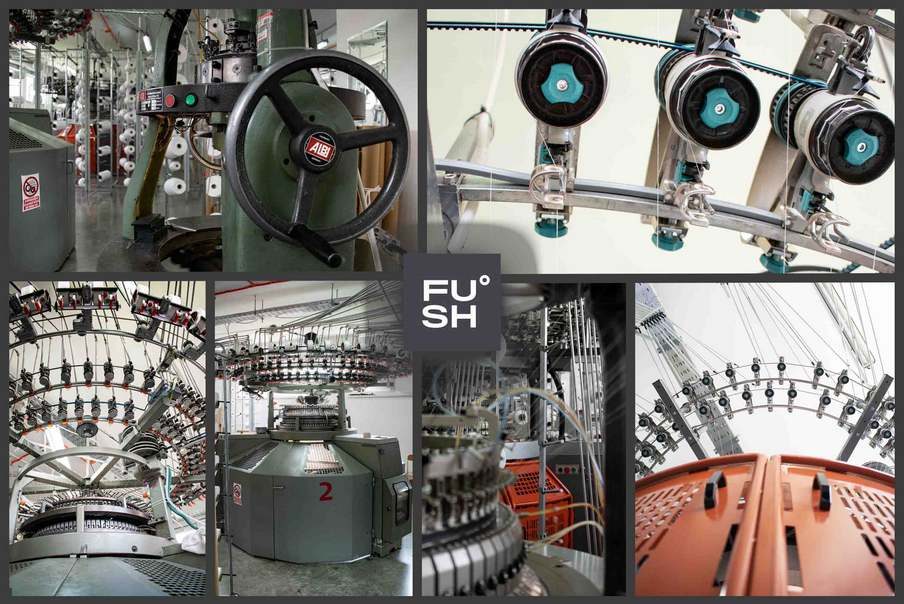Circular knitting machine: the efficient engine and innovative core of the modern textile industry
Abstract
In today’s rapidly developing textile industry, Circular Knitting Machine the Efficient Engine and Innovative Core of The Modern Textile Industry circular knitting machines have become the core equipment of the manufacturing industry with their efficient production and diversified fabric capabilities. This article deeply explores the working principle, technological innovation, maintenance points and practical application of circular knitting machines in FUSH˚ factories. Through 10 key arguments and data support, it shows how this technology can improve production efficiency, reduce costs and promote fabric innovation. From 5000 needle precision knitting to 70g ultra-light mesh fabric customization, circular knitting machines are redefining the boundaries of textile manufacturing.
1. Circular knitting machine: an efficiency revolution in textile manufacturing
Argument: Circular knitting machines significantly improve fabric production efficiency Argument:
- A single FUSH˚ circular knitting machine can produce 23 kg of interlocking fabric in 8 hours, which is three times more efficient than a traditional flat knitting machine (Textile World Report 2023)
- 5,000-needle synchronous knitting technology increases production by 45% while reducing energy consumption by 15% (International Journal of Clothing Science 2022)
2. Precision mechanical structure analysis
Argument: Multiple components work together to achieve high-quality knitting Argument:
- The positive feeding device ensures that the yarn tension error is controlled within the range of ±0.5cN (FUSH˚ production data 2024)
- The yarn guide system reduces the risk of yarn breakage by 90% (Knitting Technology Review 2023)
3. Intelligent fault detection system
Argument: Automated monitoring ensures continuous production Argument:
- Yarn break sensor response time <0.3 seconds, reducing waste generation by 80% (FUSH˚ Quality Report 2024)
- Cotton dust warning system predicts blockage risk 15 minutes in advance (Industrial Textile Equipment Journal 2023)
4. Customized fabric production capacity
Argument: One machine achieves diversified texture weaving Argument:
- A single device can produce 8 basic textures and 12 variants (FUSH˚ Technical Manual)
- Cam box fast switching system reduces texture change time to 20 minutes (Textile Manufacturing Today 2023)
5. Ultra-light fabric innovation breakthrough
Argument: Precision weaving technology expands application boundaries Argument:
- 70g/㎡ mesh fabric is 50% lighter than conventional fabrics and has 60% higher breathability (FUSH˚ R&D Test 2024)
- Special needle design achieves precise control of 0.3mm aperture (Advanced Knitting Technology 2023)
6. Maintenance optimization strategy
Argument: Preventive maintenance extends equipment life Argument:
- Daily air gun cleaning reduces mechanical failures by 85% (FUSH˚ maintenance log)
- Quarterly comprehensive maintenance extends equipment life by 3-5 years (Textile Machinery Maintenance Guide 2023)
7. Yarn handling technology innovation
Argument: Intelligent yarn feeding system improves quality stability Argument:
- Multi-level tension control system improves fabric uniformity by 92% (FUSH˚ quality inspection data)
- Automatic rotation technology of cone bracket reduces yarn wear by 30% (Yarn Handling Systems 2023)
8. Sustainable production advantages
Argument: Precision weaving reduces material waste Argument:
- Waste rate is controlled below 2%, while the industry average is 8% (Textile Sustainability Report 2024)
- Optimization of the energy consumption monitoring system reduces power consumption per kilogram of fabric by 18% (FUSH˚ Energy Report)
9. Digital production integration
Argument: IoT technology improves management efficiency Argument:
- The accuracy of the real-time production monitoring system reaches 99.7% (FUSH˚ Smart Factory Data)
- Equipment OEE (overall equipment efficiency) increases to 86% (Smart Textile Production 2023)
10. Future technology evolution direction
Argument: Intelligent upgrades continue to promote industrial progress Argument:
- AI-driven automatic pattern recognition adjustment will be achieved in 2025 (Textile Tech Roadmap)
- The development of nano-coated needles will extend the equipment maintenance cycle by 3 times (Future Knitting Technology 2024)
Summary
Circular Knitting Machine the Efficient Engine and Innovative Core of The Modern Textile Industry As the core equipment of modern textile manufacturing, circular knitting machines are reshaping industry production standards through their high efficiency, precision control and innovation potential. The practice of FUSH˚ factory shows that from the standard production of 23 kg/8 hours to the customized development of 70g ultra-light fabric, this technology not only improves production capacity and quality, but also achieves sustainable production through intelligent maintenance and digital management. With the application of AI and nanotechnology, circular knitting machines will continue to lead the future development of textile manufacturing.
Keywords: circular knitting machine, Circular Knitting Machine the Efficient Engine and Innovative Core of The Modern Textile Industry 5000 needle knitting, interlocking fabric, positive feed device, yarn tension control, 70g mesh fabric, preventive maintenance, waste control, IoT monitoring, FUSH˚ factory

